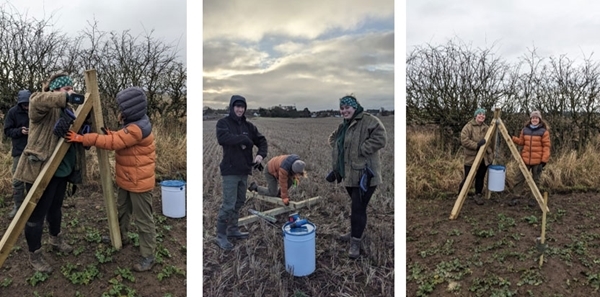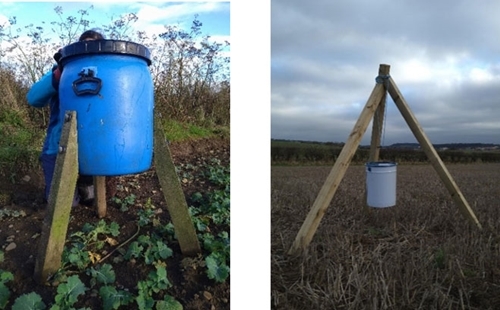Written by Rachael Hustler, Scottish Lowlands placement student
It’s been a busy start to the new year for the Scottish Lowlands research team. We’ve spent the last few weeks setting up gamebird feeders to carry out research into supplementary winter feeding for farmland birds. Myself and the other Scottish placement students have been out in the field building new tripod gamebird feeders, which will be monitored alongside standard gamebird feeders to compare any differences in species usage.
 Photos showing the process of building the new tripod gamebird feeders. Photo credits: K Goodman
Photos showing the process of building the new tripod gamebird feeders. Photo credits: K Goodman
Supplementary winter feeding of gamebirds is a management tool used to provide additional food during the ‘hungry gap’. Reduced food availability in the winter has been linked with lower survival rates, and breeding success the following year and research shows supplementary feeding can help mitigate this.
This new gamebird feeder consists of a wooden tripod from which a metal bucket is attached to hang freely. Slots cut in the bottom of the bucket allow the birds to access the grain. This differs from a traditional feeder which is a plastic barrel, with a spiral dispenser, securely attached to wooden legs. Both feeders have been filled with an enhanced gamebird mix. This is mostly wheat but also contains millet, sunflower and flax seeds. Although previously wheat has solely been used, we hope this added variety will provide additional supplementation for other farmland birds, that we know also benefit from gamebird feeders.
 Left photo shows the traditional feeder and right tripod feeder design. Photo credit: R Hustler
Left photo shows the traditional feeder and right tripod feeder design. Photo credit: R Hustler
The aim of this research is to evaluate whether the features of this new design can improve the efficiency of supplementary winter bird feeding. To reduce the use of feeders by non-target species, such as rats and deer but also still be accessible for target species such as songbirds and grey partridges.
These feeders are being monitored on all six farms involved in the PepsiCo FAB project over the next couple of months. We look forward to sharing the results!